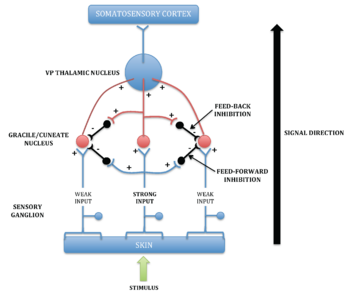Inhibitory Neuronal Circuits
Organization of inhibitory circuits[edit | edit source]
Most of the long neuronal pathways are excitatory. The inhibition effect has to be related through an interneuron specialized for inhibition. Inhibitory circuits are based on the postsynaptic inhibition (most frequently GABA or glycine mediated – there are also similar facilitatory circuits).
There are 3 types of inhibitory circuits:
- Feed-forward inhibitory circuit.
- Feed-back inhibitory circuit.
- Lateral inhibition.
Feed-forward inhibitory circuit[edit | edit source]
- Collateral branches of the excitatory afferent fibers excite inhibitory interneurons that inhibit neurons in the forward direction.
- Inhibitory pathways keep down the level of excitation and so suppress discharges from all weakly excited neurons. They also mold and modify the patterns of neuronal responses.
- Example: Iα afferent fibers from muscle receptors → spinal motor neurons.
Feed-back inhibitory circuit[edit | edit source]
- Collateral branches of the excitatory efferent fibers excite inhibitory interneurons that inhibit neurons by the feedback mechanism.
- Example: axon of a spinal motoneuron sends collateral to a Renshaw cell that inhibits the action of the same and neighboring motoneurons → the more intensely the motoneuron fires impulses, the more it turns itself off by the negative feedback.
- Because of a powerful divergence, one group of motoneurons firing strongly inhibits motoneurons in their neighborhood which may receive only weaker stimulation →
- The actual motor performance becomes more selective by the negative feedback eliminating the weakly responding motoneurons that might cause some disorder in the movement.
- Similar function have the basket cells in the hippocampus and other interneurons in the cerebral cortex.
Lateral inhibition[edit | edit source]
- Also known as: surround inhibition.
- A higher-order neuronal action which employs both feed-back and feed-forward inhibition and requires more complex neuronal systems.
- It is primarily designed to block the lateral spread of the excitatory signals and therefore increase the degree of contrast.
- Example in sensory system: tactile stimuli applied to the skin – excitatory central region is surrounded by a zone of inhibition, processing of the optical and auditory signals, it exists also within motoric pathways.
Significance of the inhibitory circuits[edit | edit source]
Activity of nerve cells is accompanied by a strong background noise, hence the signal has to be transmitted via a system of parallel lines carrying much the same signal (→ redundancy of the information). At every interconnection level, the signal has to be amplified and the noise reduced (the role of facilitatory and inhibitory local circuits) – neurons have to "shout together" to get the message across and make a reliable signal despite the noise. Inhibition action has to focus (sharpen) the picture transmitted by the neuronal pathways (e.g., Renshaw cells terminate the action of motoneurons). Target neurons actively search for "their" signals – inhibition of other signals.
Links[edit | edit source]
Related articles[edit | edit source]
- Synaptic Transmission
- Dendrite
- Axon
- Synapse
- Neuromuscular Transmission
- Membrane Potentials
- Transformation of Synaptic Input into Action Potential
Sources[edit | edit source]
Sources[edit | edit source]
- Lecture Notes: Prof. MUDr. Jaroslav Pokorný DrSc.
Bibliography[edit | edit source]
- HALL, John E – GUYTON, Arthur Clifton. Guyton and Hall Textbook of Medical Physiology. 11. edition. Saunders/Elsevier, 2005. ISBN 0721602401.
- DESPOPOULOS, Agamnenon – SILBERNAGL, Stefan. Color Atlas of Physiology. 5. edition. Thieme, 2003. ISBN 3135450058.

